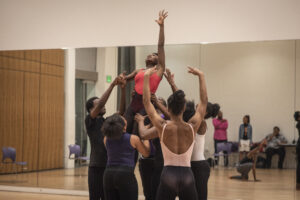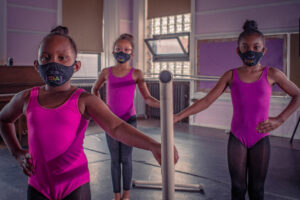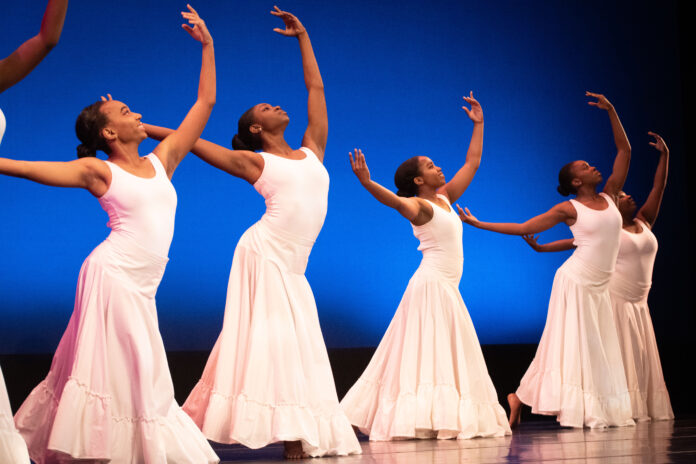Urban Media Today is excited to continue its series highlighting the Heinz Endowment Cultural Treasure Initiative Award Winners. Like Heinz, we are inspired by each organization’s work and commitment to Black creativity and cultural legacy. This week, Urban Media Today spoke with Hill Dance Academy Theatre (HDAT) Founder, CEO, and Artistic Director, Ayisha Morgan-Lee, EdD. HDAT’s mission is to “provide professional-level training in Black Dance traditions, history, culture, and aesthetics that engages and empowers students to pursue careers in Black dance.”
NOTE: This interview has been edited for length and clarity.
Urban Media Today: When the Heinz Endowment awards were announced, Vice President Janet Sarbaugh said, “These cultural treasures are diverse in their connections to Black culture, to artistic disciplines in their longevity, and in many other ways. What they have in common is a commitment to ensuring the presence of Black art and culture and our city and region.” To what do you attribute the longevity of Hill Dance Academy Theatre?
Dr. Ayisha Morgan-Lee: For me, it was the way that I grew up in my home and the way that I grew up in the dance world. My parents always encouraged me to really know who I was as a young Black girl. I tell people all the time our house, to me, felt like a museum. The walls talked with Black artwork, Black music was playing. Anything that was Black performance related, they would take me to see. So the arts were a big part of it. When I grew up going to Civic Light Opera Academy, I was the only person who looked like me. When you’re the only person in the room or there’s like one or two others, and you are the minority, not the majority, and you only have one teacher that looks like you, you want to know, ‘What else is going on?’ In the 11th grade, I performed with Norma Jean Barnes and Xpressions Contemporary Dance Company. When I auditioned for that, there were other girls who looked like me. In high school, she took us to the International Association of Blacks in Dance Conference, and when I went there, everybody was there from major Black dance companies that I had read about in magazines. I was like, “Oh my gosh! I get to see them live and in person!”
All of them were there, and I was just like, “This is what I want to do.” I know that this is possible. So I went and started looking for an HBCU that would have Dance as a major. Little did I know that Howard University was the only one at the time that had Dance as a major. I applied to Howard on a whim. I literally got the view book and turned it over, and it had a group of black dancers putting on pointe shoes. Once I got to Howard, I found out that my advisor was the board chair of that conference that I attended in 11th grade. So I got to participate in that conference for four years at Howard, and everybody who was anybody in the Black dance world came through Howard.
So that was my experience, going from being the only one to all of this around me. And I kept saying, “Why can’t we have that in Pittsburgh? Why didn’t I have that when I was growing up?” So what can I do? And I said, “I want to start an academy where this is going happen.” My students say all the time when I tell them my story, they’re like, “What? You were the only one?” Because they look around and most of everybody looks like them, including their faculty and the students they are dancing with. So for them, this is the norm. But it wasn’t the norm for me. So in that sense, I did accomplish that.
UMT: What made it so important for you to return home to Pittsburgh to do this work?
DAML: Before I left for Howard, there was a program that I was running called Dance on the Hill, which was in conjunction with my mom, who was running a program called Carlow Hill College. My students were saying, “Are you coming back?” or “We know you’re going away to college. How is this dancing going to continue?” I really wasn’t quite sure what was going to happen during my time after Howard. When I went to Howard, one thing I discovered, which was painful, is that you got to intern with all these major Black dance companies, but they were struggling. They were struggling to pay dancers. They were struggling to have all the money that they needed. So they had all this great artwork, great people, but they weren’t able to do all the things that you see other companies doing financially. So that’s when I decided I wanted to come back home and go to CMU (Carnegie Mellon University) to get a Master’s in Arts Management. So that hopefully, we didn’t have to struggle. We could do what we needed to do and not have to prove ourselves just because of the color of our skin that we are that good and we should have the money.
So that’s how it happened. I knew I always wanted a dance academy. I just didn’t know it was going to be that soon. That started in 2005. I figured maybe I had some time to go away, do some other things in the Black dance world and come back, but I didn’t because nobody else was doing that. They weren’t able to go someplace and get concert dance training from teachers and faculty who looked like them and be around students who look like them in ballet, jazz, tap, and modern (styles), so I had to come back home and make that happen.
UMT: Have you seen a proliferation of Black dance instruction in Pittsburgh since you’ve been doing this work?
DAML: I will say there are more of us who are popping up with dance academies, but ours is very different. Our goal is to train dancers for the concert stage. So when you walk through that door, no matter what you’re thinking or what your parents signed you up for, we are going to treat you as if you are preparing for a career on the concert stage to be a professional dancer. To do that, you need all of those different techniques and styles I talked about so that you can go on and dance for these major Black dance companies. We are training students in that holistic approach. I have seen some other companies that are coming up and trying to do the same thing or attempt to do the same thing. I don’t know if they’re quite there. Things are changing but not at a fast pace where you can say, “Here are all the different choices I have if I want to train in concert dance and then select one.”
I think what also makes us unique is we’re not just teaching technique. Our students also perform. We have a pre-professional company called Ju.B.Lation Spirit Filled Feet. They perform all over the country. We also take students to performances. So anytime any major Black dance company is coming, we’re in the audience, we’re on the floor. We’re watching them with my connections because now, I’m the board chair of the International Association of Blacks in Dance Conference, the conference I first attended in 11th grade. It’s come full circle, right? So now I can call up and say, “Hey, I see you’re coming to Pittsburgh. Can we get a masterclass here at HDAT? Can we get a talkback after the show?” In the dance world, it’s not just about going in and being a professional dancer; there are so many other aspects; teaching master classes, going out into the community, talking to funders, or talking to your audience. There’s just a lot going on that really helps them to prepare themselves for the concert stage.
UMT: You’re preparing them so thoroughly; hopefully, this is creating the next generation of Black dancers who will continue your legacy and who will come back or stay in Pittsburgh.
DAML: I will say what’s missing now is, we’re training them, but training them to go where? Pittsburgh doesn’t have a professional Black dance company. So if you want to stay here, or if you’ve got all this training, where can you go? So we’ve had conversations about what does that look like now that we’ve trained them on a professional level, to have a professional Black dance company? New York has Alvin Ailey. Dallas has Dallas Black Dance Theater. Dayton has Dayton Contemporary Dance Company. Pittsburgh doesn’t have one. That’s a huge piece that’s missing, not being able to have that representation in your own city.
UMT: What’s involved in creating that in Pittsburgh?
DAML: A lot of things. The backing behind the company from the community, the backing foundation in terms of money. A company means that you have up to 12 professional dancers you have on contract. They’re getting paid, they’re getting health benefits. They’re getting everything that you would get during your 9-5 job. They have performance opportunities. They have a space to call their own. [For example] Pittsburgh Ballet Theater performs at the Benham Center all the time. So if I started, just for the heck of it, Ayisha Morgan-Lee Professional Dance Company, where will they be housed? Where will they perform? Will people come to the shows? You need money to bring in the choreographer. So there is a lot that goes behind it, and I think Pittsburgh is just now catching up to all of the inequities that are happening with Black arts organizations. And then you want to throw on top of that a professional dance company? Not there yet.
UMT: Hopefully soon.
DAML: I hope so.

UMT: It looked like 2021 was a big year for your organization because you have the Heinz Cultural Treasures Endowment, the National Endowment for the Arts funding, you got your new, expanded location, and then you were named the board chair of the International Association of Blacks in Dance. What did it mean to you to see your dream expanding?
DAML: One, for me, especially regarding the Pittsburgh Cultural Treasures, people were noticing us. We were being recognized. I always say to this day, we find ourselves to be Pittsburgh’s best-kept secret. That’s not something that we want, we want people to know about us. There are still people today who don’t know about us. We’ve been here 18 years. So that recognition was like, “Wow! The Pittsburgh community, they now see what we’re doing.”
I think a challenge for us is we work with children. We work with students ages 3-18. Often, people think, “Oh, they’re just children. They’re just kind of playing around.” No. We make sure that our dancers are prepared professionally, even at the ages of 3-18. Because we work with children, I think a lot of people just write us off. People come to our spring dance concert, which we have at the August Wilson Center, and they’re shocked! Like those were children performing, and they were performing with major choreographers that I didn’t have a chance to work with until I was in college. That excited me because now people can say, “I see what you’re doing. I see you’re working with children and teaching them about Black dance, and we can now say kudos to you.”
Now being board chair of the International Association of Blacks in Dance (IABD), it’s come full circle. I’ve been a part of the organization. It’s why I came to want to do professional dance in the first place. And now I’m here helping to shepherd this next generation in with IABD and the management and all of that. So that was exciting.
Having a facility has been my dream from day one. Because how can you do your art if you don’t have a place to do it? There are still things that need to be done, but now we have a space, and now the renovations can happen. Our staff has offices. I thought that was important for our children to be able to see ownership. It’s amazing when people come in, and they’re like, “You all own this space?” Yes, we do; Black people own the space, and not only do they see that, I try to make sure I give back to my community, too. Anybody we’re working with, vendors from the landscape people to the snow removal, to the cleaning, are people who look like us. You don’t always get to see that. Black Wall Street, that’s what I call a lot of things up in here. You get to see what my parents saw back in the day in their neighborhoods. And that’s important to me.
UMT: I think that’s amazing, and I think these kids will realize when they get older, and they travel the world and experience new things, they’ll realize how important it was that you really curated this space for them to see people who look like them doing a little bit of everything and they’ll really appreciate that.
DAML: Yes. I was asked many times in trying to find a location, “Why the Hill District? Why the Hill District?” This is important for our students. Because a lot of our students do not come from the Hill. Our students come from all over Pittsburgh. So there are some who are coming from different places, like Cranberry, Homewood, East Liberty, or the North Side. Would they come to the Hill any other time? I don’t know. So they get to see the importance of being here in the vibrant community of the Hill District. You don’t have to go to Monroeville, the North Hills, or downtown to have a credible dance academy. It’s right here in the Hill District.
UMT: The performance of Crossings, which tells the story of a young, Black woman confronting racism, was supposed to happen in early 2020. You were already planning on performing something that poignant back in 2020, and then the pandemic came, and you also the “racial reckoning” after the police murder of George Floyd. So now, two years later, when your kids are finally able to perform, what’s the energy of bringing it to the stage after all the things that we’ve seen on the world stage?
DAML: I think it’s twofold. One, I tell people all the time, HDAT had been doing those kinds of works before the pandemic happened. What we know have been injustices have been there. We’ve been telling these stories. We’ve told the story of the four girls killed in the 16th Street Baptist Church Bombing. Anytime we tell something, we always tell the students the history and the background. We also bring the parents in. We want them to be able to show that on stage in movement, but they don’t get to talk. We’ve done two pieces about the church bombing, and we’ve really had to explain to them what that was like. Imagine you’re in church, dressed up in your Sunday dress, and BOOM– explosion. What does that mean? And seeing children who are your age lying on the ground. We’ve always done those different stories. We’ve told stories, and it is not always in terms of our struggles and our history but also of our triumphs.
So we’ve always done that. For us, Crossings was different because now we had a predominantly white organization, Pittsburgh Youth Chorus, who came to us and said, ‘We’d like to tell this story. We realize to tell this story, though, we need to partner with a Black organization to make this work.” It was a wonderful partnership because they came to us in a very truthful, honest, and intentional way. That doesn’t always happen. You have white organizations who come to you, and they’re just checking off the box. I said we have to set this up so that our students understand it. So we had workshops with the children and with the parents. They got to speak with Ysaÿe Barnwell (Crossings’ composer and performer) on Zoom one day and asked her all these questions. It was absolutely wonderful to see. It’s all the stuff that we talk about that we want our children to be able to learn from. The stuff they’re telling us we can’t teach in schools anymore. This is all the stuff that we were able to bring to them, and they were very receptive. Even though Covid canceled our previously scheduled dates, in January of 2022, we just set out a plan. We need to bring the students together. We did a fun day for them to just get to know each other. You’re bringing in two different age groups, two different cultures, two different disciplines in terms of dance and music, and we want them to be able to tell this story on stage. If it’s not working behind the scenes, how will it work live? How’s it going to be portrayed live? When everything [racial uprising] happened during Covid, that wasn’t new to us as Black people. It was just now that the world had to pay attention. Now you get to see it and have some sympathy and see what we’re going through. It was a wonderful sold-out audience. It’s something I’d like to be able to see us do a little bit more of, too, with these partnerships and also interdisciplinary.

UMT: I’m seeing studies coming out now talking about academic learning loss due to the pandemic. Would you say that there’s been something similar, maybe a cultural or arts loss with young people as well?
DAML: When the pandemic happened, you remember, at that time, nobody knew what was going to happen. Everybody said, “We’ll see you at the end of April.” Then it kept going. Eventually, we went into Zoom mode like everybody else to finish our season. And we said, if we’re gonna do this, we’re going to have to make sure they have the resources. We had two foundations help us to create what I call dance home studios in a box. They had a ballet bar, they had floor, and they had earbuds so that they could zone out everything. We had meetings with families about their internet connection. “Where is your internet connection? Do you have seven people on the internet at one time? Do you have a space big enough that they can dance in it? What kind of way do we need the tablet to be able to see your body?” It helped us to continue what we were doing and to bring dance to them. We also had a section where for 30 minutes, we would leave the Zoom open so they can chit chat because they weren’t talking to their friends like they used to, you know? For some people, it worked well. Others, it didn’t. When you’re dancing, you know if you are working really hard in that Zoom sweating versus when you’re in the studio, and a lot of that was not happening. But we were just trying to keep the thought of dance and art alive with them in this new space. And we did that from March of 2020 until September of 2021.
We also learned, though, how to do video and dance. We weren’t able to do our spring dance concert, but we had two seniors. I had both young ladies since they were three. They were turning 18, and we wanted to celebrate them. We brought in the choreographers they wanted, and we went to different locations so that we could now do dance and film. We were able to do that, even still in Covid, so we did learn a lot, and we’re still trying to figure out how we then take that and continue it. We were able to produce a show for the spring concert via film, so now everybody can buy tickets. If your aunt is in Louisiana, she can buy a ticket for it. So how do we keep those kinds of things up? So that was exciting, but it was one of those things where a lot of our three and six-year-olds, they couldn’t take it. So that was a huge population for us that we lost because they just couldn’t do the Zoom.
You know, it’s just a way of life. We have to deal with it. They still wear their mask. My main thing is just trying to keep them healthy and trying to get us back to how we used to do things in 2019, knowing that some things are different and we just have to work like that now.
UMT: Wow. Congrats to you for weathering that storm.
DAML: And that’s the other thing we did, we talked to the parents. We had Sunday Fit days, so anybody on the camera and who lived in your house could come in. It allowed us to tap into our network because we had one of our choreographers from New Zealand do a fitness class with parents. We had health people come and talk about Covid for children. Because we know that it was a little scary for them, and they weren’t understanding all that was going on. Those are different things that we did, and I’m just grateful and thankful to the community and the parents that we were able to last. There are some organizations that unfortunately did not come out of Covid. They had to shut down, but we were able to keep going, thanks to the faculty and staff. We were constantly thinking, “What else can we do?” Because we know we can’t do how things how we normally do them, but we were trying to keep some structure and trying to keep everyone alive mentally, physically, spiritually, and emotionally.
UMT: It was a trying time for everybody. So I think it’s a testament to the trust the parents had in you and the care that you have for not just their children but also their families that they really stuck with you.
DAML: Yeah. We do have, on top of our faculty and staff, we have a wonderful parent support system. The parents told me that we missed the performance days and seeing each other. When we did come back, it was like a whole family reunion because we hadn’t seen each other in so long! And because we usually live here Monday through Sunday, they’re used to seeing each other in passing. And so it’s exciting to be back now.
UMT: With your new location, you’ve said you want to “expand community access and creative engagement across the Pittsburgh arts ecosystem.” How are you doing that?
DAML: There are a number of things. We just hired a director of operations who’s in charge of opening up the facility to the community. I see it as a performing arts center where there are several different things going on. We have Hill Dance Academy Theater, and we have other artists who are downstairs on the first floor. Crew Productions, LLC, is a media, photography, and videography production company. We also have Folk Arts Quilts, a Quilter who makes award-winning Quilts and also helps the students learn how to sew, which is important. We have Edo Scribes & Pleasantries, who do jewelry making, costume design, and masquerades. And then we have Breezy Elements, who make body butter.
So I see it as a place where it’s not just dance, but it’s the whole compass of the performing and visual arts coming together. We’ll be having different workshops or events for the community, and not just the Hill community, but the larger community can come in, and they’re all Black and Brown artists. You can come in and you can learn from them. You might see an art show. You might see a dance show.
Then we have a residency, so I can bring in artists who can stay here and create art with the students and not skip a beat themselves as artists. I see it as an encompassment of artists working, doing what they need to do, teaching, workshops, performances, all of that happens on the campus.
UMT: How can the community support HDAT?
DAML: I would definitely always drive people to our website, www.5678hdat.org.
UMT: When I realized what the numbers were a dance count, I was like, “Oh, that’s cute!”
DAML: 5, 6, 7, 8–That’s the cue for dancers to get ready! We always have community events. We have an October Halloween community event, which is open to the public. We have our regular dance academy classes, which students do have to enroll in. We also have rental opportunities now with the space that we have in our event center. Those are all things that are up and coming. Of course, people can help financially with donations to continue to keep the facility going and scholarships for students.
We’re always looking for more students. Know that you don’t have to learn how to know how to dance. I get that a lot. “Well, my child hasn’t danced.” That’s okay. That’s why we’re here. We teach you how to dance. As long as you are dedicated and have the commitment, and are willing to come, we’re here. We are in conversation about doing some adult dance, which will hopefully be starting soon.
We’re already planning for the 20th anniversary. It’s going to be big. We are bringing back our annual spring dance concert at the August Wilson Center, April 21st-23, 2023. We have our Kwanza event coming up the week after Christmas.
We’re open to connecting with anybody who wants to just learn more about HDAT and maybe even how to partner with us. It might not happen overnight, but we always are looking forward to that as well.
Images courtesy of HDAT



































